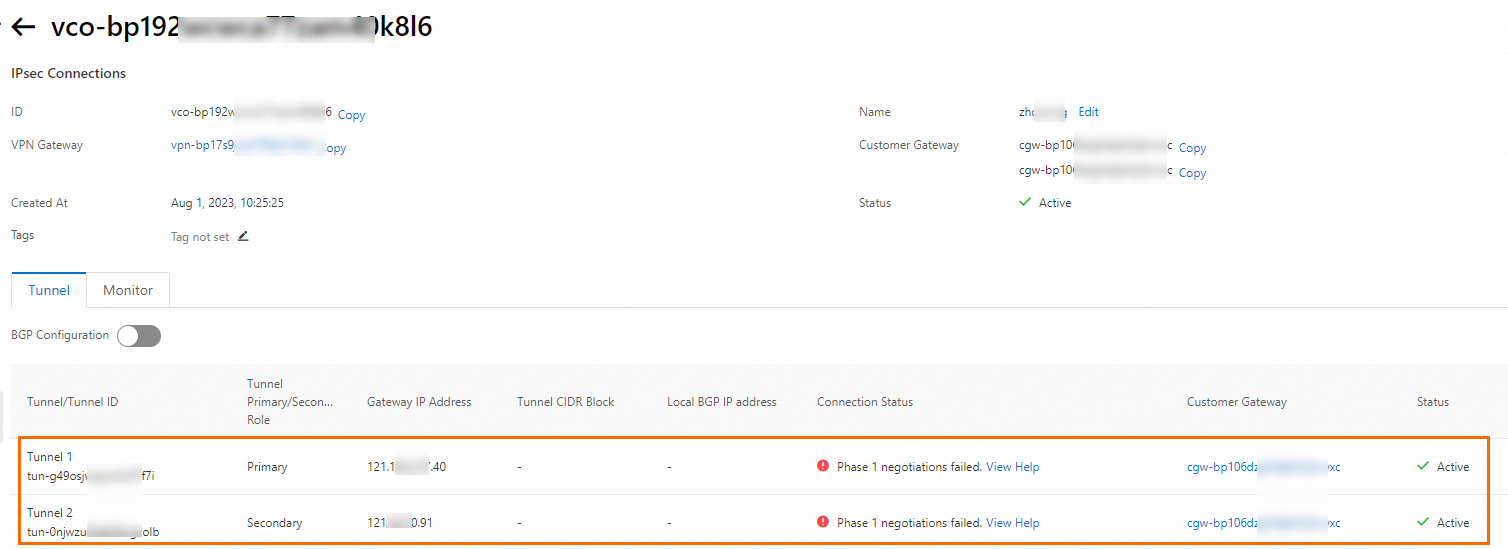An IPsec-VPN connection in dual-tunnel mode has an active tunnel and a standby tunnel. If the active tunnel is down, the standby tunnel takes over to ensure service availability. This topic describes how to upgrade a VPN gateway to enable the dual-tunnel mode.
Supported regions and zones
The following table describes the regions and zones in which you can upgrade IPsec-VPN connections to the dual-tunnel mode.
Region | Zone |
China (Hangzhou) | Zone K, Zone J, Zone I, Zone H, and Zone G |
China (Shanghai) | Zone K, Zone L, Zone M, Zone N, Zone B, Zone D, Zone E, Zone F, and Zone G |
China (Nanjing - Local Region) | Zone A |
China (Shenzhen) | Zone A, Zone E, Zone D, and Zone F |
China (Heyuan) | Zone A and Zone B |
China (Guangzhou) | Zone A and Zone B |
China (Qingdao) | Zone B and Zone C |
China (Beijing) | Zone F, Zone E, Zone H, Zone G, Zone A, Zone C, Zone J, Zone I, Zone L, and Zone K |
China (Zhangjiakou) | Zone A, Zone B, and Zone C |
China (Hohhot) | Zone A and Zone B |
China (Ulanqab) | Zone A, Zone B, and Zone C |
China (Chengdu) | Zone A and Zone B |
China (Hong Kong) | Zone B, Zone C, and Zone D |
Singapore | Zone A, Zone B, and Zone C |
Thailand (Bangkok) | Zone A |
Japan (Tokyo) | Zone A, Zone B, and Zone C |
South Korea (Seoul) | Zone A |
Philippines (Manila) | Zone A |
Indonesia (Jakarta) | Zone A, Zone B, and Zone C |
Malaysia (Kuala Lumpur) | Zone A and Zone B |
India (Mumbai) | Zone A and Zone B |
UK (London) | Zone A and Zone B |
Germany (Frankfurt) | Zone A, Zone B, and Zone C |
US (Silicon Valley) | Zone A and Zone B |
US (Virginia) | Zone A and Zone B |
Prerequisites
Before you upgrade a VPN gateway, make sure that the following requirements are met:
Descriptions of the upgrade
A VPN gateway is unavailable during the upgrade. The existing connections are interrupted. We recommend that you upgrade a VPN gateway during a network maintenance window to prevent service interruptions.
The upgrade takes about 10 minutes. During this period, the VPN gateway cannot forward traffic.
You cannot manage the VPN gateway during the upgrade process.
Procedure
- Log on to the VPN gateway console.
In the top navigation bar, select the region of the VPN gateway.
On the VPN Gateways page, find the VPN gateway that you want to manage and click its ID.
In the upper-right corner of the details page, click Enable Zone Redundancy.
In the Enable Zone Redundancy dialog box, specify a vSwitch and enable environment verification. Make sure that the requirements are met and click Enable.
If the environment verification failed, refer to the Prerequisites section of this topic for troubleshooting.
After you click Enable, the system starts the upgrade.



